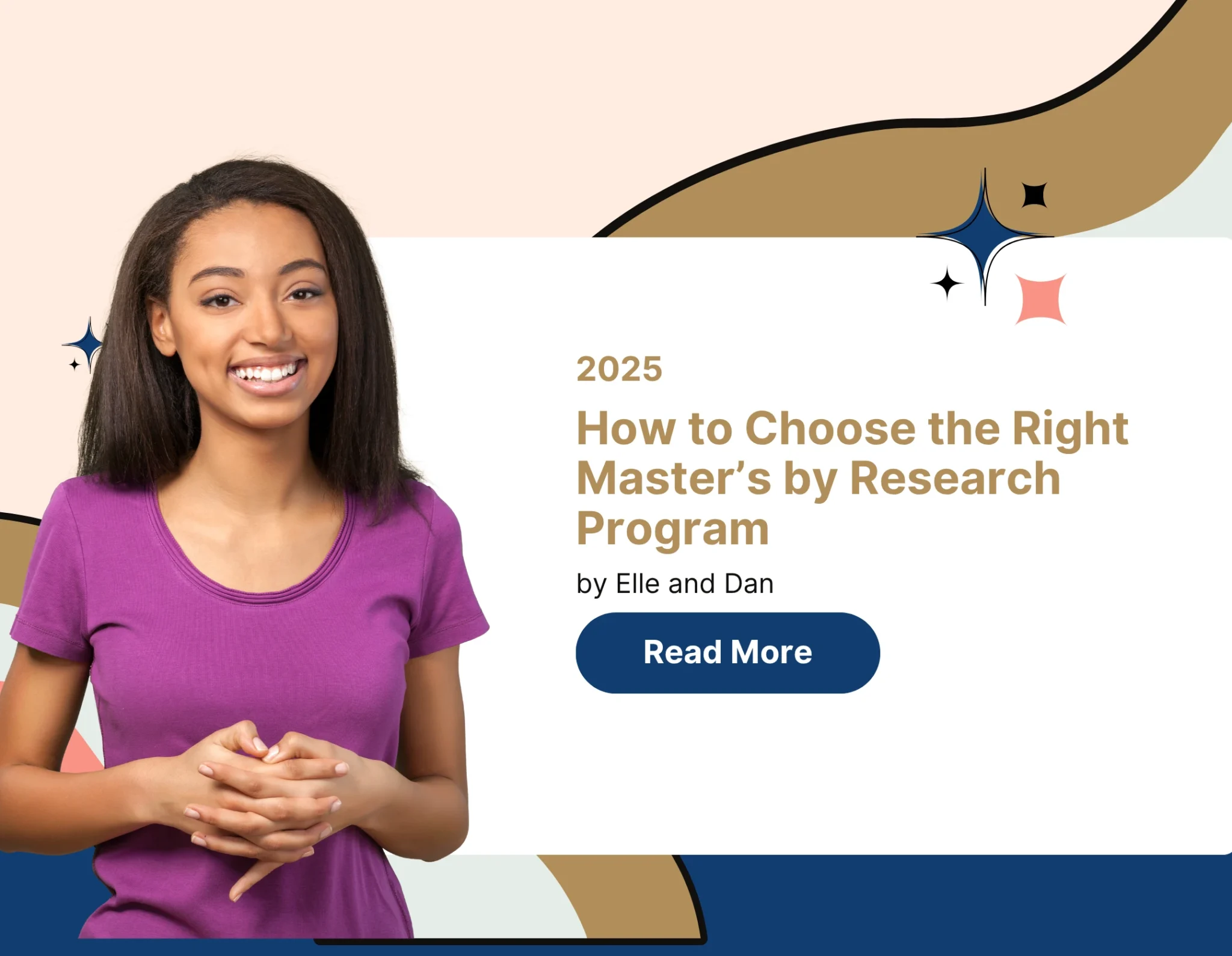How to Choose the Right Master’s by Research Program
Table of Contents
Introduction
Deciding on a Master’s by Research program is more than choosing a university—it’s selecting the right mentor, environment, and resources for your academic future. Unlike taught degrees, research-focused programs demand close alignment between your interests and a supervisor’s expertise. A well-matched program sets the stage for meaningful publications, networking, and career growth. In this guide, we’ll show you how to evaluate and select the perfect research master’s, and introduce how Elle & Dan’s expert Research Consulting, Education Consulting, and Business Consulting services can support you at every step—from proposal development to interview prep. Ready to find your ideal research fit? Let’s begin.
What Is a Master’s by Research?
A Master’s by Research (often called MRes, MPhil, or MSc by Research) centres on an independent research project rather than regular lectures. You collaborate closely with one or more supervisors to design, execute, and write up a thesis or dissertation. While some programs include limited coursework, the majority of your time is devoted to original investigation. This format is ideal if you:
Desire deep subject mastery
Aim to transition seamlessly into a PhD
Seek hands-on research experience in labs or archives
Value intensive mentorship and small cohort collaboration
Benefits of a Research-Based Master’s
Specialist Expertise
You gain in-depth knowledge in a focused area, positioning yourself as an emerging expert.Publication Potential
Many programs encourage journal articles or conference presentations, which strengthen your CV.Mentorship & Networking
One-on-one guidance from supervisors and connections within research networks accelerate your career.PhD Preparation
Completing a research master’s provides the training and credentials for doctoral applications.Industry & Consultancy Appeal
Employers value research skills—critical thinking, project management, data analysis—in both academic and non-academic roles.
Key Factors to Consider
4.1 Supervisor Expertise & Fit
Your supervisor is the cornerstone of your research experience. Assess fit by examining:
Publication Record: Are they publishing in high-impact journals?
Research Alignment: Does their recent work match your interests?
Supervision Load: How many students they oversee—too many may dilute attention.
Communication Style: Request an informal discussion or video call to gauge rapport.
Action Step: Draft a shortlist of 5–7 supervisors and send each a concise (200-word) research outline.
4.2 Research Facilities & Resources
The quality of labs, libraries, or archives can make a critical difference:
Laboratory & Equipment Access: For science and engineering disciplines—are specialised instruments available?
Library & Data Archives: For humanities and social sciences—strength of collections, digital access.
Computing Infrastructure: High-performance clusters, software licenses (e.g., MATLAB, SPSS).
Industry Collaborations: Partnerships with R&D centres or corporate sponsors.
Action Step: Arrange virtual tours or webinars with department administrators, and ask current students about day-to-day lab use.
4.3 Program Structure & Requirements
Research master’s vary widely in structure:
Balance of Coursework vs. Research: Some include up to 30% taught modules.
Milestones & Assessments: Ethics approvals, poster presentations, annual reviews.
Duration & Flexibility: Full-time typically 1–2 years; part-time may extend to 3–4 years.
Examination Format: Thesis only, or thesis plus oral defense (viva voce).
Action Step: Download the program handbook from the university website and map out key deadlines against your schedule.
4.4 Funding & Scholarship Opportunities
Research projects often require financial support:
University-Funded Scholarships: Merit-based, discipline-specific grants.
External Fellowships: Opportunities like DAAD, Fulbright, or Inlaks.
Assistantships: Teaching or research assistant roles that provide stipends.
Industry Sponsorships: Projects co-funded by companies in biotech, engineering, or finance.
Action Step: Create a funding tracker spreadsheet listing amounts, deadlines, and application requirements.
4.5 Institutional Reputation & Rankings
Rankings should inform—but not dictate—your choice:
Subject-Specific Rankings: QS or Times Higher Education by discipline.
Research Impact Metrics: Citations per faculty member, H-index scores.
Alumni Outcomes: Career paths in academia, industry, or consulting.
Action Step: Compare your shortlisted institutions across at least three ranking tables and review departmental research reports.
4.6 Future Career Pathways
Consider how your degree will position you post-graduation:
PhD Pathway: Does the program have a robust pipeline for doctoral studies?
Industry Roles: Are there connections to R&D divisions, consultancy firms, or tech incubators?
Policy & Think Tanks: Opportunities in government agencies or non-profits.
Entrepreneurship: University support for spin-outs, incubators, and innovation hubs.
Action Step: Research LinkedIn profiles of recent graduates to gauge career trajectories and networking reach.
Step-by-Step Selection Process
Self-Assessment: Clarify your research interests, skillset, and career goals.
Supervisor Outreach: Email 5–7 potential supervisors with a succinct proposal synopsis.
Evaluate Responses: Give priority to supervisors who respond promptly and with genuine interest.
Program Comparison: Rank options based on facilities, funding, supervision, and career outcomes.
Application Preparation: Tailor your Statement of Purpose, refine your CV, and secure references.
Submission & Follow-Up: Submit applications well ahead of deadlines and confirm receipt.
Interview Preparation: Schedule mock interviews through our Education Consulting service to build confidence.
Common Pitfalls & How to Avoid Them
Relying Solely on Rankings: A top-ranked university may lack a supervisor in your niche—always verify departmental strengths.
Overlooking Culture Fit: Lab culture, departmental size, and location affect well-being—visit if feasible.
Neglecting Funding Timelines: Late scholarship applications can force deferral—start at least six months early.
Excessive Coursework Load: Too many taught modules can reduce research time—opt for balanced structures.
How Elle & Dan Can Help
Applying to research master’s programs is complex. Elle & Dan offers tailored support through:
Supervisor Matching: Our Research Consulting team analyses your profile to recommend supervisors whose interests align closely with yours.
Proposal Development: Expert guidance on crafting a clear, compelling research proposal that stands out.
Funding Strategy: Our Education Consulting service identifies optimal scholarships and fellowships, with personalized application coaching.
Interview Coaching: Practice mock interviews through our Business Consulting arm, so you articulate your vision with confidence.
Accessibility Support: If you have accommodations needs, our Disability Support team liaises with universities to ensure a supportive environment.
Explore our full suite of services to streamline every application step and maximise your chance of success.
Conclusion & Next Steps
Choosing the right Master’s by Research program is a pivotal decision shaping your academic trajectory and career. By meticulously evaluating supervisors, facilities, funding, and future pathways—and following the structured process outlined above—you’ll secure a program that fuels your passion and unlocks new opportunities. Ready to get started? Visit our Contact Us page to schedule a free consultation with one of our expert advisors. Let Elle & Dan guide you to research success.
Frequently Asked Questions
Q1: When should I begin contacting supervisors?
Aim to reach out 6–9 months before your intended start date to allow time for feedback and proposal refinement.
Q2: How long should my research proposal be?
Typically 500–1,000 words, clearly outlining your objectives, methodology, and expected outcomes.
Q3: Can I apply to multiple supervisors within the same department?
Yes—just tailor each email and ensure each supervisor’s expertise matches your interests.
Q4: What if I don’t secure funding immediately?
Consider part-time teaching or research assistantships. Some universities allow deferred entry until funding is confirmed.
Q5: How does a research master’s differ across countries?
In the UK, MRes often includes some taught modules; in Australia, MPhil may emphasize independent work. Always review program structures carefully.

